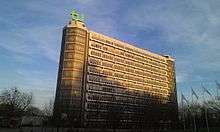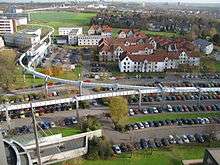Technical University of Dortmund
| Technische Universität Dortmund | |
|
Official logo of the TU Dortmund University | |
Former names | Universität Dortmund |
|---|---|
| Type | Public |
| Established | 16 December 1968 |
| Endowment | €161,4 million |
| Rector | Ursula Gather |
Academic staff | 294 (2011) |
Administrative staff | 3,381 (2011) |
| Students | appr. 33,500 (2015) |
| Location | Dortmund, North Rhine-Westphalia, Germany |
| Campus | Urban/Suburban |
| Affiliations | UAMR - University Alliance Metropolis Ruhr |
| Website |
www |
TU Dortmund University (German: Technische Universität Dortmund) is a university in Dortmund, North Rhine-Westphalia, Germany with over 20,000 students, and over 3,000 staff. It is situated in the Ruhr area, the fourth largest urban area in Europe.
The university is highly ranked in terms of its research performance in the areas of physics, electrical engineering, chemistry and economics.[1] It is considered one of the best universities in Germany.
History
The University of Dortmund was founded in 1968, during the decline of the coal and steel industry in the Ruhr region. Its establishment was seen as an important move in the economic change (Strukturwandel) from heavy industry to technology. The university's main areas of research are the natural sciences, engineering, pedagogy/teacher training in a wide spectrum of subjects, special education, and journalism. The University of Dortmund was originally designed to be a technical university, but in 1980, it merged with the adjacent Pädagogische Hochschule Ruhr that housed mostly humanities.
In 2006, The University of Dortmund hosted the 11th Federation of International Robot-soccer Association (FIRA) RoboWorld Cup. The university's robot soccer team, the Dortmund Droids, became vice world champion in the RoboWorld Cup 2002 and finished third in 2003.
Campuses

Following the Zeitgeist of the late 1960s in Germany, the university was built auf der grünen Wiese (on the meadows) about 2 miles (3.2 km) outside of downtown Dortmund. It consists of two campuses, North and South, which since 1984 have been linked by an automated hanging monorail system, the H-Bahn, that crosses the quaint nature reserve between the campuses at a height of about 50 feet (15 m). One of the most prominent buildings in the university is the Mathetower (Mathematics Tower), which houses the faculty of Mathematics.
Faculties
- Faculty of Mathematics
- Faculty of Physics
- Faculty of Chemistry and Chemical Biology
- Faculty of Computer Science
- Faculty of Statistics
- Faculty of Biochemical and Chemical Engineering (BCI)
- Faculty of Mechanical Engineering
- Faculty of Electrical Engineering and Information Technology
- Faculty of Spatial Planning
- Faculty of Civil Engineering/Architecture
- Faculty of Economics/Business and Industrial Sociology
- Faculty of Pedagogy and Sociology
- Faculty of Special Education/Rehabilitation Sciences
- Faculty of Social Sciences, Philosophy and Theology
- Faculty of Cultural Studies
- Faculty of Art and Sport Sciences
Student life




The university has a student radio station called eldoradio* which can be listened to also via livestream (link: see below).
Department of Computer Science
The first point of registration for .de-domains was at the Dortmund University Department of Computer Science.
The first .de-domain (currently the most popular German ccTLD in terms of number of registrations) was www.uni-dortmund.de.
Partner Universities
- Beit Berl, Israel
- Birzeit University, Birzeit, Palestinian Territories
- Budapesti Mûszaki és Gazdaságtudományi Egyetem, Budapest, Hungary
- Canisius College, Buffalo, NY
- Carnegie Mellon University, Pittsburgh, PA
- Chungnam National University (충남대학교), Daejeon, Republic of Korea
- Dalian University of Technology (大连理工大学), Dalian, People's Republic of China
- Georgia Institute of Technology, Atlanta, GA
- Hamilton College, Clinton, NY
- Hoseo University (호서대학교), Asan, Republic of Korea
- Iowa State University of Science and Technology, Ames, IA
- John Carroll University, University Heights, OH
- Lehigh University, Bethlehem, PA
- Michigan State University, Lansing, MI
- National Taiwan University (國立台灣大學), Taipei, Taiwan
- Oglethorpe University, Atlanta, GA
- Politechnika Szczecińska, Szczecin, Poland
- Ростовский государственный университет (Rostov State University), Rostov-on-Don, Russia
- Salahaddin University, Erbil, Iraq
- Shanghai Jiao Tong University (上海交通大学), Shanghai, People's Republic of China
- Swinburne University of Technology, Australia
- University of Sulaimani, Kani Askan, Iraq
- Tohoku University (東北大学), Sendai, Japan
- Tongji University (同济大学), Shanghai, People's Republic of China
- Universidad de Concepción, Concepción, Chile
- Université de Picardie Jules Verne, Amiens, France
- University of Dar es Salaam, Dar es Salaam, Tanzania
- University of Dohuk, Dohuk, Iraq
- University of Ghana, Kumasi, Ghana
- University of Iowa, Iowa City, IA
- University of Montevallo, Montevallo, Alabama Montevallo, AL
- University of Sheffield, Sheffield, United Kingdom
- University of Southern California, Los Angeles, CA
- University of the Philippines Diliman, Quezon City, Philippines
- University of the Western Cape, Bellville, South Africa
- University of Virginia, Charlottesville, VA
- Univerzita Jana Evangelisty Purkyně v Ústí nad Labem, Ústí nad Labem, Czech Republic
- Xi'an Jiaotong University (西安交通大学), Xi'an, People's Republic of China
- Within the Erasmus programme:
- Dublin City University, Dublin, Ireland
- Instituto Universitario di Architettura di Venezia, Venice, Italy
- Royal Institute of Technology (Kungliga Tekniska högskolan), Stockholm, Sweden
- Liverpool John Moores University, Liverpool, United Kingdom
- Miskolci Egyetem, Miskolc, Hungary
- Università degli Studi di Pisa, Pisa, Italy
- Universiteit Twente, Enschede, Netherlands
- Univerzita Karlova V Praze, Prague, Czech Republic
- Newcastle University, Newcastle upon Tyne, United Kingdom
- Özyeğin University, Istanbul, Turkey
- Yıldız Teknik Üniversitesi, Istanbul, Turkey
- Hacettepe University, Ankara, Turkey
- Within the Network of Euroregional Universities:
- Universität Osnabrück, Osnabrück, Germany
- Westfälische Wilhelms-Universität, Münster, Germany
- Universiteit Twente, Enschede, Netherlands
- Catholic University Leuven, Leuven, Belgium
- Radboud Universiteit Nijmegen, Nijmegen, Netherlands
- Cooperations with other German universities:
- Ruhr-Universität Bochum, Bochum
- Witten/Herdecke University, Witten
- Universität Bielefeld, Bielefeld
- Universität Duisburg-Essen, Duisburg
- Universität Duisburg-Essen, Essen
- Rheinisch-Westfälische Technische Hochschule Aachen, Aachen
- Bergische Universität Wuppertal, Wuppertal
- Technische Universität München, Munich
- Karlsruhe Institute of Technology, Karlsruhe
- Universität Siegen, Siegen
- Technische Universität Darmstadt, Darmstadt
- Friedrich-Alexander-Universität Erlangen-Nürnberg, Erlangen
- Universität Kassel, Kassel
- Universität Stuttgart, Stuttgart
- Universität Rostock, Rostock
- Justus-Liebig-Universität, Gießen
- Eberhard-Karls-Universität Tübingen, Tübingen
Honorary doctorates
Former president of Germany, Johannes Rau was awarded an honorary degree from the university in 2004.
Carl Djerassi was awarded an honorary degree for his science-in-fiction in 2009.
See also
References
- ↑ (German) Uni-News: Handelsblatt Rangking
External links
- Official homepage of the TU Dortmund University
- Homepage of the H-Bahn (monorail)
- Official homepage of the robot soccer team "Dortmund Droids"
- Homepage of the university radio station, eldoradio* (in German)
- Universität Dortmund in moveonnet
Coordinates: 51°29′33″N 7°24′51″E / 51.49250°N 7.41417°E
|
